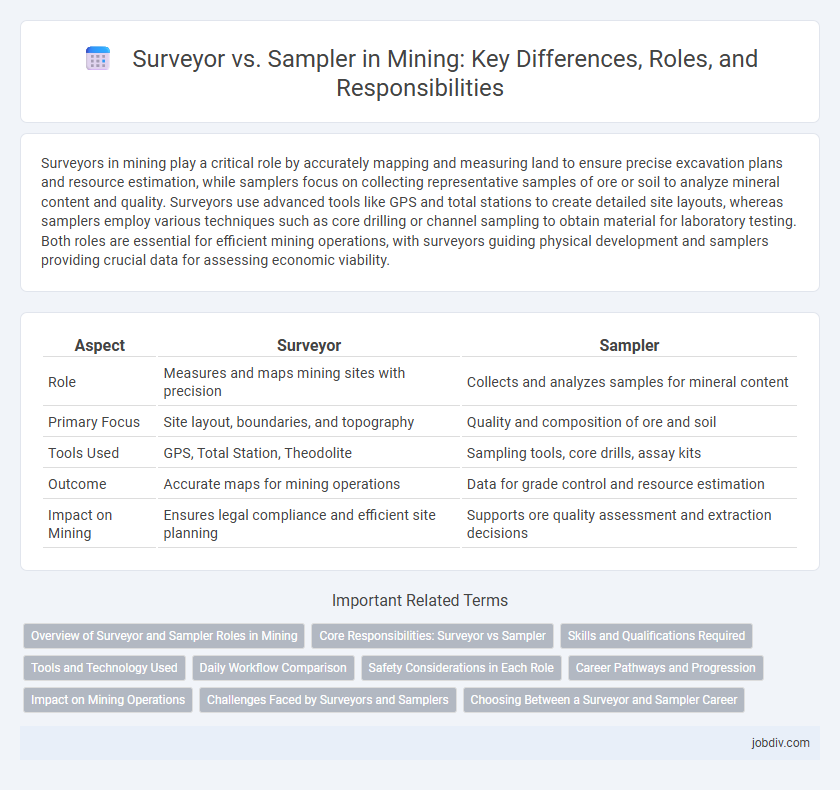Surveyors in mining play a critical role by accurately mapping and measuring land to ensure precise excavation plans and resource estimation, while samplers focus on collecting representative samples of ore or soil to analyze mineral content and quality. Surveyors use advanced tools like GPS and total stations to create detailed site layouts, whereas samplers employ various techniques such as core drilling or channel sampling to obtain material for laboratory testing. Both roles are essential for efficient mining operations, with surveyors guiding physical development and samplers providing crucial data for assessing economic viability.
Table of Comparison
| Aspect | Surveyor | Sampler |
|---|---|---|
| Role | Measures and maps mining sites with precision | Collects and analyzes samples for mineral content |
| Primary Focus | Site layout, boundaries, and topography | Quality and composition of ore and soil |
| Tools Used | GPS, Total Station, Theodolite | Sampling tools, core drills, assay kits |
| Outcome | Accurate maps for mining operations | Data for grade control and resource estimation |
| Impact on Mining | Ensures legal compliance and efficient site planning | Supports ore quality assessment and extraction decisions |
Overview of Surveyor and Sampler Roles in Mining
Surveyors in mining are responsible for measuring and mapping the terrain to establish property boundaries, design mine layouts, and ensure accurate excavation processes. Samplers collect representative samples of mined materials or ore to analyze their composition and quality, which guides operational decisions and resource valuation. Both roles are critical for optimizing extraction efficiency and maintaining regulatory compliance within mining operations.
Core Responsibilities: Surveyor vs Sampler
Surveyors in mining are responsible for precise measurement, mapping, and boundary determination to ensure accurate mine planning and safe extraction. Samplers focus on collecting representative geological samples from ore bodies and materials to assess grade quality and inform processing decisions. Both roles are critical for optimizing resource evaluation and operational efficiency in mining projects.
Skills and Qualifications Required
Surveyors require expertise in geospatial analysis, proficiency with surveying instruments such as total stations and GPS equipment, and strong mathematical skills to accurately measure and map mining sites. Samplers must possess knowledge of sampling methods, familiarity with mineral identification techniques, and attention to detail to collect representative ore or soil samples accurately. Both roles demand understanding of safety regulations and mining industry standards, but surveyors typically require formal education in engineering or geomatics, while samplers often gain skills through specialized training or field experience.
Tools and Technology Used
Surveyors in mining employ advanced GNSS receivers, total stations, and laser scanners to capture precise spatial data and create accurate topographic maps. Samplers utilize automated sampling devices, core drills, and laboratory mineral analyzers to extract and analyze representative geological samples for ore grade assessment. Both roles integrate GIS software and digital data management systems to enhance precision and streamline mining operations.
Daily Workflow Comparison
Surveyors in mining focus on mapping and measuring mine sites daily using advanced GPS and laser scanning technology to ensure accurate spatial data for planning and safety. Samplers concentrate on collecting representative rock or soil samples from designated locations each shift to analyze mineral content and quality for resource evaluation. Both roles require precise data handling and coordination but differ in the type of data collected and tools used, influencing the workflow and operational support they provide.
Safety Considerations in Each Role
Surveyors in mining prioritize precise measurements to ensure structural integrity and prevent hazardous collapses, often working with advanced instruments in potentially unstable environments. Samplers handle ore and geological samples, necessitating strict adherence to contamination controls and protective gear to avoid exposure to harmful dust and chemicals. Both roles require rigorous safety protocols tailored to their specific tasks to minimize risks and maintain site safety standards.
Career Pathways and Progression
Surveyors in mining specialize in mapping and measuring mine sites, ensuring accurate spatial data for operational planning, while samplers focus on collecting and analyzing mineral samples to assess ore quality. Career progression for surveyors often leads to roles such as senior surveyor, mine planner, or geospatial analyst, whereas samplers may advance to laboratory supervisor, quality control manager, or metallurgist positions. Both pathways offer technical expertise with opportunities to transition into management and specialized consultancy within the mining industry.
Impact on Mining Operations
Surveyors provide precise spatial data crucial for accurate mine planning, enhancing operational efficiency and safety. Samplers collect representative material samples that directly influence ore grade estimation and resource classification, impacting production decisions. Together, their roles optimize resource extraction and minimize operational risks in mining projects.
Challenges Faced by Surveyors and Samplers
Surveyors in mining face challenges such as maintaining precise measurements in rugged terrains and continuously updating geological maps amid changing site conditions. Samplers encounter difficulties ensuring representative sample collection due to variability in ore composition and the need to prevent contamination during extraction. Both roles demand strict adherence to safety protocols and accuracy to support efficient resource estimation and extraction planning.
Choosing Between a Surveyor and Sampler Career
Choosing between a surveyor and sampler career in mining depends on your interest in data collection versus spatial analysis. Surveyors specialize in measuring land and mapping geological features using advanced technology like GPS and GIS software, critical for mine planning and safety. Samplers focus on collecting and analyzing mineral or soil samples to assess ore quality and environmental conditions, essential for resource evaluation and compliance with regulations.
Surveyor vs Sampler Infographic

 jobdiv.com
jobdiv.com